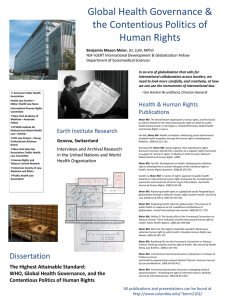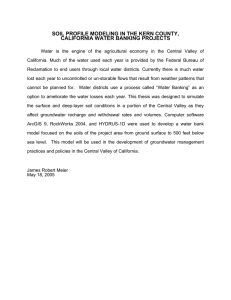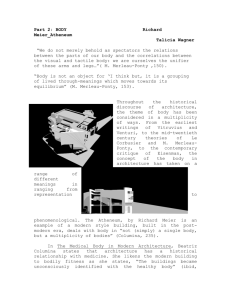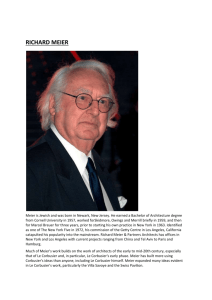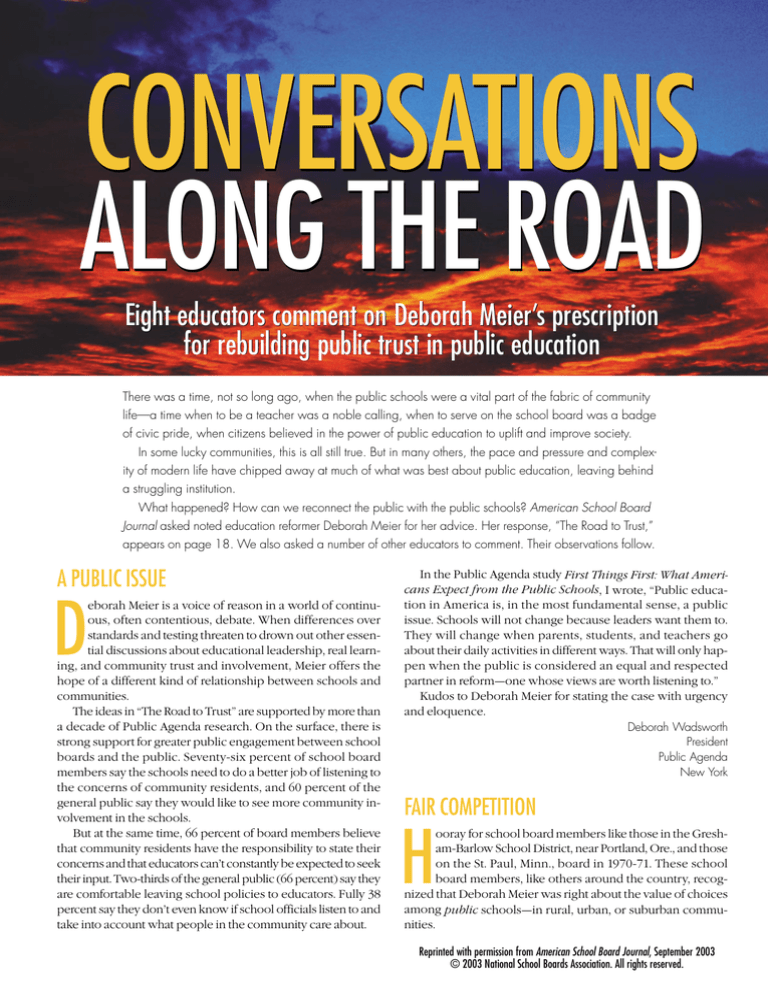
CONVERSATIONS
ALONG THE ROAD
Eight educators comment on Deborah Meier’s prescription
for rebuilding public trust in public education
There was a time, not so long ago, when the public schools were a vital part of the fabric of community
life—a time when to be a teacher was a noble calling, when to serve on the school board was a badge
of civic pride, when citizens believed in the power of public education to uplift and improve society.
In some lucky communities, this is all still true. But in many others, the pace and pressure and complexity of modern life have chipped away at much of what was best about public education, leaving behind
a struggling institution.
What happened? How can we reconnect the public with the public schools? American School Board
Journal asked noted education reformer Deborah Meier for her advice. Her response, “The Road to Trust,”
appears on page 18. We also asked a number of other educators to comment. Their observations follow.
A PUBLIC ISSUE
D
eborah Meier is a voice of reason in a world of continuous, often contentious, debate. When differences over
standards and testing threaten to drown out other essential discussions about educational leadership, real learning, and community trust and involvement, Meier offers the
hope of a different kind of relationship between schools and
communities.
The ideas in “The Road to Trust” are supported by more than
a decade of Public Agenda research. On the surface, there is
strong support for greater public engagement between school
boards and the public. Seventy-six percent of school board
members say the schools need to do a better job of listening to
the concerns of community residents, and 60 percent of the
general public say they would like to see more community involvement in the schools.
But at the same time, 66 percent of board members believe
that community residents have the responsibility to state their
concerns and that educators can’t constantly be expected to seek
their input. Two-thirds of the general public (66 percent) say they
are comfortable leaving school policies to educators. Fully 38
percent say they don’t even know if school officials listen to and
take into account what people in the community care about.
In the Public Agenda study First Things First: What Americans Expect from the Public Schools, I wrote, “Public education in America is, in the most fundamental sense, a public
issue. Schools will not change because leaders want them to.
They will change when parents, students, and teachers go
about their daily activities in different ways. That will only happen when the public is considered an equal and respected
partner in reform—one whose views are worth listening to.”
Kudos to Deborah Meier for stating the case with urgency
and eloquence.
Deborah Wadsworth
President
Public Agenda
New York
FAIR COMPETITION
H
ooray for school board members like those in the Gresham-Barlow School District, near Portland, Ore., and those
on the St. Paul, Minn., board in 1970-71. These school
board members, like others around the country, recognized that Deborah Meier was right about the value of choices
among public schools—in rural, urban, or suburban communities.
Reprinted with permission from American School Board Journal, September 2003
© 2003 National School Boards Association. All rights reserved.
Encouraging educators and parents to create new schools
allows school boards to introduce the dynamics of fair competition into a district. Effective organizations seek ways to improve. Asking educators for innovative proposals is a great way
to encourage them.
In 1971, the St. Paul school board said “yes” to parents, community activists, and educators who dreamed of a small, K-12
public school option. I was one of the lucky educators who
benefited from the board’s openness. St. Paul Open School has
won national awards and grants to replicate itself, having pioneered such ideas as:
■ An adviser/advisee system
■ Graduation based on demonstration of knowledge
■ Combining classroom work with community research.
What about suburban or rural communities? Four suburban
districts in Oregon recently created the Center for Advanced
Learning, a new charter school that will serve high school students from all four districts. The Oregonian, the state’s largest
newspaper, called this “a really good idea.”
Minnesota’s Independent School District 196, serving Rosemount, Apple Valley, and other suburban communities, has received widespread recognition for a public school option
teachers created at the Minnesota zoo.
And International Falls, Minn., a rural district, allowed teachers to create a popular elementary school-within-a-school.
Families choose between self-contained classrooms (first
grade in one room, second in another, and so on) or a multiage classroom, similar to the one-room schoolhouse idea.
With federal support, our center described six vital and
three valuable things that school boards should expect of each
school. (The report, “What Should We Do,” is available online
at www.centerforschoolchange.org.)
Deborah Meier is right. No policy solves every problem. But
whether it’s through a district or a charter option, students and
systems gain from more public school choices.
Joe Nathan
Director, Center for School Change
Hubert H. Humphrey Institute of Public Affairs
University of Minnesota
Minneapolis
THE OBLIGATIONS OF PUBLIC SERVICE
D
eborah Meier has tackled a vital issue: how communities
are and ought to be tied to their schools. One of the fascinating and troubling things about 20th century education reform was the furious effort by administrative and
classroom progressives to insulate schooling from the community. Deeming their own judgment far superior to that of
common citizens, administrative progressives worked to buffer
governance and administration from noneducators. I agree
with Meier that this was an enormous error.
Unremarked upon by Meier, however, is the tradition of
classroom progressives, dating from John Dewey and George
Counts, who think it appropriate for educators to use schools
as forums to promote personal values and beliefs even—or especially—when these subvert the broader community’s. Believing American society coarse, materialistic, racist, and
corrupted by corporate interests, these classroom progressives
resist public monitoring or control of educational content.
Their discomfort with directives from parents and voters has
especially colored their reaction to demands for accountability. Meier herself has long embraced this tradition—as when she
asserts that the Texas accountability system is a product of “distrust” and has not increased trust in the schools, or when she
implies that accountability is an untoward nuisance unwisely
imposed upon educators.
It seems more than a little naive for those who have argued
that schools must undo the racism, sexism, and classism that
purportedly plague Americans to wonder why those same
Americans may wish to keep a short rein on educators and may
be skeptical of their agendas. It is disingenuous to imagine distrust is purely the legacy of the administrative progressives.
Rather than offering bromides about trust, public educators
should attend to the obligations of public service. So long as
leading educational thinkers call for “consensus” in which their
voice is first among equals, ridicule the values of most Americans, and regard trust as an entitlement to be recaptured rather
than a solemn obligation to be continually earned, reclaiming
“trust” will prove a long, bleak pursuit.
Frederick M. Hess
Resident Scholar
American Enterprise Institute
Washington, D.C.
NOT BY SIZE ALONE
D
eborah Meier raises some excellent points. The effectiveness of the public leadership of our school districts
through school boards has been the topic of much discussion in recent years. Meier is certainly right when she
observes that the decline in public participation through
school boards would be devastating to our children’s education. I appreciate her passion for this issue, and I found interesting her suggestion that the best way to guarantee public
engagement and engender trust in the schools is through small,
more-intimate school districts.
Having grown up attending a small rural school, however,
and serving now as the superintendent of a 7,000-student suburban school, I would argue that it is not simply the size of the
school or district that promotes trust. Schools and school districts throughout the country, no matter how large or small,
have earned the trust of their constituents. That trust is built on
the efforts school board members, administrators, and staff
members make to connect to parents and the community at
large.
Rebuilding trust, I believe, is more about understanding
how to engage the public in smaller groups and smaller venues
than it is about smaller being automatically better. Economy of
Reprinted with permission from American School Board Journal, September 2003
© 2003 National School Boards Association. All rights reserved.
scale in the operation of the school district does provide opportunities for more specialized expertise and service, as well
as lower per-pupil cost for many services. In my experience,
trust, community participation, and healthy school board governance are not necessarily immediate outgrowths of size or
type of school or district.
The annual Phi Delta Kappa/Gallup Poll of the Public’s Attitudes Toward the Public Schools indicates that people give
higher marks to their own schools and school districts than to
those they do not know. I believe this phenomenon is at work
when we laud our own form of school or district governance
and tend to criticize other forms of governance in other schools
or districts. It is important not to generalize in this way. We need
trust and strong citizen leadership on our school boards, and
that can be obtained in all venues—not only in small or charter
schools.
Kenneth A. Dragseth
National Superintendent of the Year, 2003
Superintendent of Schools
Edina, Minn.
CONVERSATIONS WITH THE COMMUNITY
D
eborah Meier provides a thoughtful, if partial, analysis of
the disconnect between schools and their communities.
She is right to point to the consolidation of school districts into increasingly larger units and the concomitant
distancing of students and their families from the governance
of their schools as a key place to intervene. We know schools
work best when students and parents have strong connections
to both the governance and educational structures of their
schools.
Meier suggests that school boards, and the educators they
hire, should work to build stronger and more trusting relationships with their communities. At times she argues that the key
relationships are with the parents and students schools serve,
and indeed, the educator-student relationship is central to the
complex educational enterprise.
But Meier also acknowledges the need to repair the more
difficult relationship between those who run schools and the
vast majority of those in every community who do not have
children in school. We need to build trust between schools and
those whose only contact with schools is likely to come at tax
time—those who seem to know only what the hypercritical
media publicize about the schools and what state and federal
officials with a privatization agenda focus on.
The question, then, is what to do. Meier suggests “building
a communitywide consensus about the essential purposes of
schools” and “agreeing on what to do about minority viewpoints.”
These two suggestions require different kinds of conversation between educators and the broader community. The conversations must be structured to make the messiness of
democracy safe. This requires ground rules so all can be heard
and so all respect other points of view. It requires a moderator
who can hold people to the ground rules. It requires that the
conversation have a substantive structure so that it actually
goes somewhere. And it requires that there is follow-through
on ideas raised in one meeting.
The conversations might start, as Meier suggests, around
“the essential purposes of schools.” But my sense is that won’t
be a draw for many of the 60 to 70 percent of community members who are disinvested in the schools. Perhaps a more fruitful place to start would be with a conversation about what
people value in their community—why they live there, what
about their community they want to protect and expand, and
how the schools support those values. My experience is that
starting with what the community itself values almost always
brings people in and helps them understand anew their stake
in schools their own children no longer attend.
Finally, I would suggest that at least some of the early conversations be held outside schools. They can be held in community centers, in church meeting rooms, in fire
halls—wherever the community at large meets. This would
show that we mean it when we say we value the community’s
input. It’s the first step in building the trust that Meier so rightly says we need to rebuild.
Harris Sokoloff
Executive Director
Center for School Study Councils
Graduate School of Education
University of Pennsylvania
Philadelphia
POLICY, NOT SIZE, MATTERS
T
he world of education owes Deborah Meier an enormous
debt for her leadership, scholarship, and passionate commitment. It is thus with some reluctance that I take strong
issue with her longing backward glance at the bygone
days when school districts were small and board members
were intimately involved in the details of school curriculum and
administration.
Meier supports her conclusions with personal observations, and I do not doubt her statement, “I’ve seen it happen.”
So have I.
I agree with her major conclusion that education accountability must be more than a litany of test scores. But my experience with school boards throughout the nation does not
suggest that a district’s size influences the degree to which
board members embrace the “vast areas of critical significance
(such areas as oral language, teamwork, reliability, initiative,
and judgment)” that Meier rightly regards as important. Indeed,
board members from small and large districts can be equally
Reprinted with permission from American School Board Journal, September 2003
© 2003 National School Boards Association. All rights reserved.
enlightened or bigoted, willing to challenge students or committed to the abolition of rigor, defenders of established science or dedicated to the imposition of a personal religious
agenda on the school curriculum.
Before we extol the virtues of “local control,” let us remember that the 10th Amendment to the Constitution, from which
that concept arises, reserves powers to the states—not to local
school systems. Most important, “local” is not necessarily wise,
good, and caring, as Meier presumes. The bureaucrats at the
federal and state level upon whom we so easily heap abuse are
the same ones whose regulations fight local policies that justify racism, sexism, and discrimination against disabled students.
Fifty years ago, Linda Brown found scant comfort from the
well-intentioned local control of the school board of my home
town, Topeka, Kan.
I like small-district board members—I’m married to one. But
it is the fairness and quality of the policies my spouse and her
colleagues enact, not the size of their district or their well-intentioned familiarity with constituents, on which their success
as education policy makers should be judged.
Douglas B. Reeves
Chairman, Center for Performance Assessment
Swampscott, Mass.
‘COMMUNITY’ MUST BE EVERYONE
D
eborah Meier’s thought-provoking article raises a problem without a solution. In keeping with what our students are confronted with, we—as the stewards of public
education—must provide the educational competencies
required to help them live and work cooperatively in the global environment.
Like Meier, I am saddened by the “manufactured culture” of
distrust for public schools by external detractors. Having served
for 11 years on an urban school board and regularly talked with
fellow board members around the country, I have witnessed
and heard about this distrust—not just by the general public,
but by people at the federal and state government levels as well.
Public education has come under attack by politicians seeking to secure recognition and votes, by the business community trying to promote its theories of downsizing and doing more
with less, and by the media that serve as a vehicle for both.
These purported theories are based on economies of scale
rather than need. We know that students learn at different rates
and mature differently. That is reality, not theory. Still it is incumbent on us to reverse this scenario or we will never attract
qualified, committed persons to serve as board members.
Meier’s comment on building a sense of community is valid,
but that community should not be limited by city, county, or
district lines. All children deserve and should receive a sound
basic education in all public schools. If we believe this, then the
funding will be in place to help make it a reality. Paramount to
developing a sense of democracy is the emergence of a sense
of urgency for maintaining, enriching, and improving public
education.
It is a travesty that board members have had to seek recourse
in the courts to ensure that states finance a basic education for
all students. But is there the collective public will to embrace
this concept?
To do this—to advance the ideals of democracy—we must
ensure that students are guaranteed the inalienable right to life,
liberty, and the pursuit of happiness promised in the Declaration of Independence. All who support public education and
hold it as a fundamental action know that it must be undergirded by local, state, and national communities to be sustained.
Florence Johnson
Buffalo Public Schools Board of Education
Buffalo, N.Y.
GOVERNMENT SCHOOLS, OR PUBLIC SCHOOLS?
M
ore students, fewer districts? Centralization of authority for the conduct of the public schools is counterintuitive. In the traditional American system, families
and the “villages” that raised the children were gathered to provide for the children’s formal education, a process
that was blessed by and financed by the “village,” as well as by
the public authority. This gathering took many forms, as some
communities were stable, some transient, some small, some
large, some financially weak, and some wealthy. Some were
ready to stand behind all their neighborhood’s children, and
some were ready to jettison that responsibility when their own
offspring had outgrown home. All this was and is messy. This
is no surprise: Democracy, the means for free people to govern
themselves, is messy.
The drift toward centralized, bureaucratic control of the details of schooling has been a gradual process over the past three
decades. There are many causes, some arising from varying regional histories, others from inattention, still others (to put it
bluntly) from selfishness and disinterest in one’s neighbors.
The more schooling has been perceived as a wholly predictable process, and thus a matter of production, the more the
values of large scale have been stressed.
Traditional allies of public education—the universities and
the local press—have been silent. The failure of the people to
nurture the habits of democracy and of government to respect
those habits has been costly. Deborah Meier reminds us that
we are on a path leading to government schools rather than
public schools. The difference is fundamental.
Theodore Sizer
Professor Emeritus
Brown University
Providence, R.I.
Reprinted with permission from American School Board Journal, September 2003
© 2003 National School Boards Association. All rights reserved.

